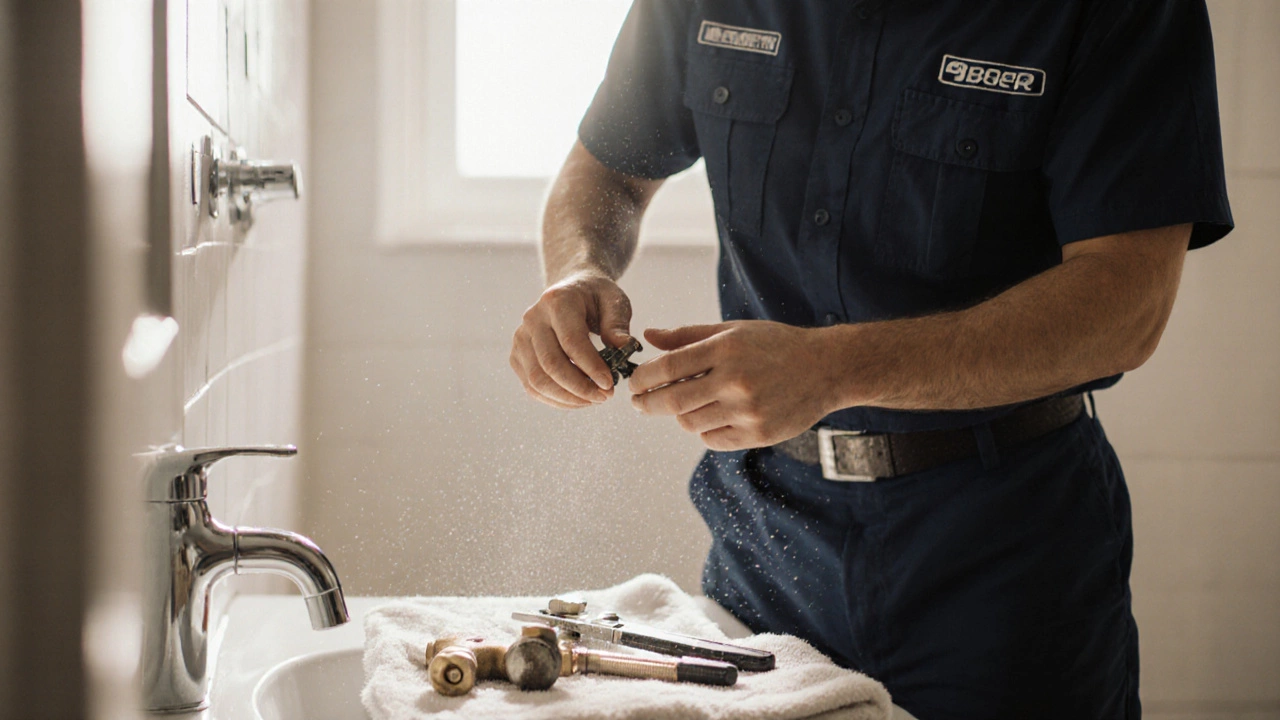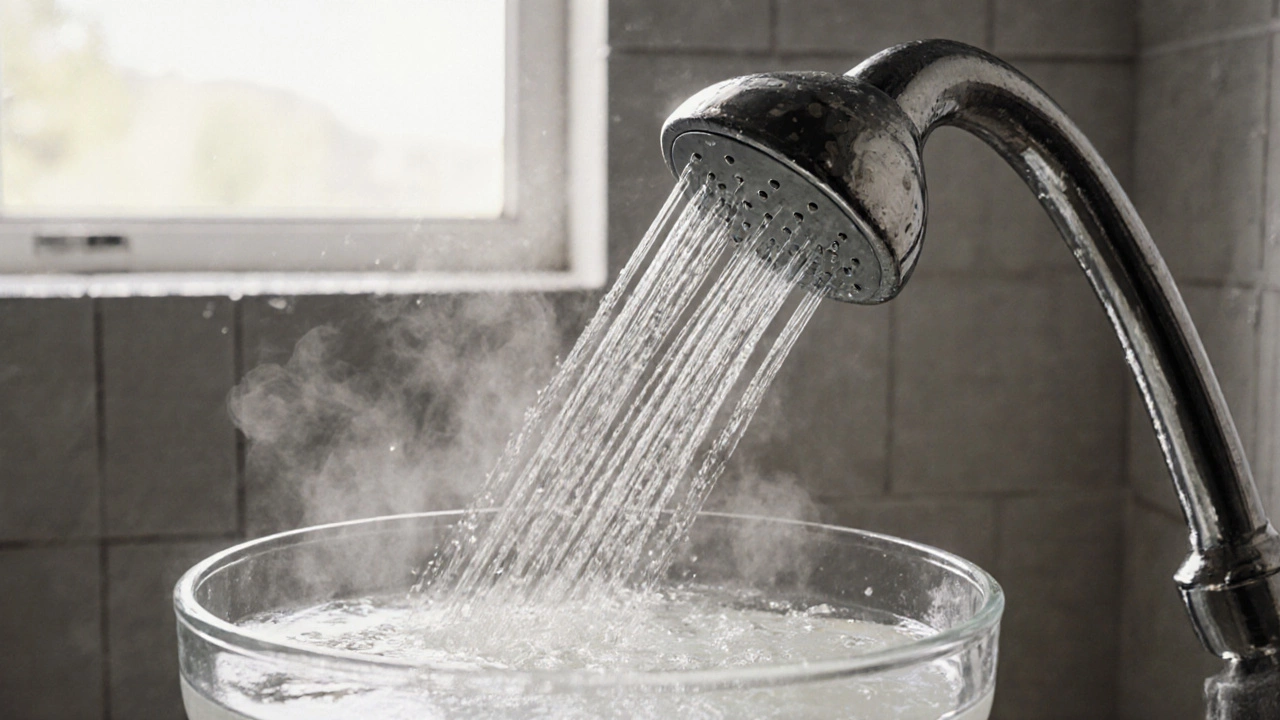If your shower runs cold but the sink next to it gushes hot water, you’re not imagining things. This isn’t just annoying-it’s a clear sign something’s wrong with your plumbing or water heating system. And the good news? It’s usually not a full water heater replacement. Most of the time, it’s a simple fix you can handle yourself before calling a plumber.
It’s Not the Water Heater
If the sink has hot water, your water heater is working. That’s the first thing to understand. A broken water heater would mean no hot water anywhere-in the kitchen, bathroom, laundry. But if only the shower is cold, the problem is somewhere between the heater and the showerhead. The heater is fine. Something’s blocking, diverting, or misrouting the hot water just for that one fixture.The Mixing Valve Is the Most Likely Culprit
Most modern showers use a pressure-balancing or thermostatic mixing valve. This device blends hot and cold water to give you a steady, safe temperature. Over time, these valves get clogged with mineral buildup-especially in areas with hard water like Auckland. When that happens, the valve can’t let enough hot water through. The result? A trickle of lukewarm or cold water, even when you turn the knob all the way to hot. You can test this. Turn on the sink hot water and let it run for a minute. Then go to the shower and turn it on. If the shower starts cold but warms up slowly, the valve is probably clogged. If it stays cold from the start, the valve might be stuck or broken. Replacing a shower mixing valve isn’t hard if you’re handy. Shut off the water, remove the handle, take out the valve cartridge, and swap it with a new one. Most hardware stores sell universal replacement kits for under $50. Just bring the old one with you to match the model.Blocked or Kinked Hot Water Line
Another common cause is a kinked or blocked pipe leading to the shower. This often happens in older homes where pipes were poorly installed or have shifted over time. If the hot water line to the shower runs through a tight space-like behind a wall or under a floor-it can get pinched. That reduces or cuts off the flow of hot water. Look for signs: Is the shower the farthest fixture from the water heater? Are there other fixtures on the same branch line that also have low hot water pressure? If yes, the problem is likely in the supply line. Try flushing the line. Turn off the main water supply. Open the shower valve and let any remaining water drain. Then, disconnect the showerhead and attach a garden hose to the pipe. Turn the water back on briefly to blast out debris. If you see grit or scale coming out, you’ve found your culprit.Showerhead or Aerator Clog
Don’t overlook the showerhead itself. Mineral deposits can build up inside the tiny holes, especially if you have hard water. This doesn’t stop hot water from reaching the shower-it just restricts flow so badly that it feels cold. The water might actually be hot, but it’s coming out so slowly you don’t notice the temperature. Try this: Remove the showerhead and soak it overnight in white vinegar. The acid dissolves lime scale and rust. Rinse it off, screw it back on, and test. If the flow improves and the water feels hotter, that was the issue. You can also buy a new showerhead for under $20 if the old one is too worn.
Thermostatic Valve in the Water Heater Is Faulty
Some water heaters-especially tankless models-have built-in thermostatic controls that adjust output based on demand. If that sensor fails, the heater might only deliver hot water to low-demand fixtures like the sink, but not to high-demand ones like the shower. Tankless heaters are common in newer homes in Auckland. If yours is less than 10 years old and you’ve noticed a recent drop in shower performance, this could be the issue. The fix? A technician needs to check the temperature sensor and control board. It’s not a DIY job, but it’s cheaper than replacing the whole unit.Cross-Connection Between Hot and Cold Lines
Sometimes, hot and cold water lines get accidentally connected-usually during a DIY repair gone wrong. This is called a cross-connection. It means cold water is leaking into the hot water line, lowering the temperature at the shower. How to check? Turn off the cold water supply to the water heater. Then go to the shower and turn on the hot tap. If water still comes out-cold or lukewarm-you have a cross-connection. This usually happens because a faulty cartridge in a single-handle faucet or valve is letting cold water backflow into the hot line. The fix involves tracing the plumbing and replacing the faulty valve. It’s not always obvious where the leak is, so if you suspect this, it’s worth calling a plumber.Water Pressure Imbalance
If your home has low water pressure overall, the shower might be the first to suffer. Showers need more water flow than sinks. A sink can run hot with just a trickle. A shower needs a steady stream. If the hot water line is too narrow, or if there’s a pressure-reducing valve set too low, the shower won’t get enough flow to feel hot-even if the water is technically hot. Check your water pressure with a simple gauge (they cost $15 at hardware stores). Attach it to an outdoor spigot or washing machine valve. Normal pressure is 40-60 psi. If it’s below 40, you may need a pressure booster or to adjust the main valve.
What to Do Next: A Simple Checklist
Here’s a step-by-step way to troubleshoot this yourself:- Check if other bathrooms or fixtures have the same problem. If only one shower is affected, it’s local.
- Remove and soak the showerhead in vinegar for 6-8 hours.
- Turn off the water, disconnect the shower arm, and flush the pipe with a hose.
- Test the sink and shower side by side. If the sink heats up fast but the shower takes minutes, the valve is likely clogged.
- If you have a tankless heater, check the display for error codes.
- If nothing works, shut off the main water and call a licensed plumber to inspect the mixing valve or supply lines.
When to Call a Professional
You don’t need to call someone for every little issue. But if you’ve tried the steps above and the shower is still cold, or if you smell gas, hear strange noises from the water heater, or notice water leaking from walls or floors, stop. That’s when you need a pro. Plumbers in Auckland see this exact problem all the time. It’s one of the top 5 service calls in winter. Most jobs take under an hour and cost between $150 and $300. That’s far cheaper than waiting until the valve fails completely and floods your bathroom.Prevention Tips
To keep this from happening again:- Install a water softener if you’re in a hard water area like Auckland.
- Flush your water heater once a year to remove sediment.
- Replace showerheads every 2-3 years, even if they still work.
- Use a filter on the water heater inlet if you have well water.
Hot water should be reliable. When it’s not, it’s rarely because the whole system broke. More often, it’s one small part that’s clogged, worn, or misaligned. Fix that, and your shower will work like it should-without a big bill or a long wait.
Why does my sink have hot water but my shower doesn’t?
Your water heater is working fine, so the problem is isolated to the shower. The most common causes are a clogged mixing valve, mineral buildup in the showerhead, a kinked hot water line, or a pressure imbalance. These issues block or reduce hot water flow specifically to the shower, while the sink still gets full pressure.
Can a faulty shower valve cause only cold water in the shower?
Yes. The mixing valve in your shower blends hot and cold water. If it’s clogged with limescale or broken, it won’t let enough hot water through. This is especially common in older homes or areas with hard water. Replacing the valve cartridge usually fixes it in under an hour.
Should I replace my water heater if only the shower has no hot water?
No. If your sink, bathtub, and laundry all have hot water, your water heater is working. Replacing it would be unnecessary and expensive. The issue is in the plumbing between the heater and the shower-likely a valve, pipe, or fixture problem.
How do I know if my showerhead is clogged?
Remove the showerhead and turn on the water. If the flow is strong and hot from the pipe, the showerhead is clogged. Soak it in white vinegar overnight. If the flow improves after cleaning, that was the issue. Mineral buildup blocks the tiny holes, reducing flow and making the water feel cold even if it’s hot.
Is this a sign of a bigger plumbing problem?
Not necessarily. If only one shower is affected, it’s usually a localized issue like a valve or showerhead. But if multiple fixtures lose hot water over time, or if you notice low pressure everywhere, you might have a main line blockage, a failing water pressure valve, or a problem with your tankless heater’s control system. In those cases, get a professional inspection.


